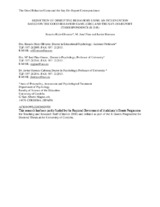Mostrar el registro sencillo del ítem
Reduction of disruptive behaviors using an intervention based on the Good Behavior Game and the Say-Do-Report Correspondence
| dc.contributor.author | Ruiz Olivares, Rosario | |
| dc.contributor.author | Pino Osuna, M. José | |
| dc.contributor.author | Herruzo Cabrera, Javier | |
| dc.date.accessioned | 2024-04-08T11:36:24Z | |
| dc.date.available | 2024-04-08T11:36:24Z | |
| dc.date.issued | 2010 | |
| dc.identifier.issn | 1520-6807 | |
| dc.identifier.uri | http://hdl.handle.net/10396/27832 | |
| dc.description.abstract | Disruptive behavior can waste a great deal of teaching time in the classroom, leading to feelings of frustration in teachers and an increase in academic failure among pupils. The prior research indicates that intervening in these kinds of behaviors improves the classroom atmosphere and facilitates the learning process. With this in mind, the aims of this research paper are a) to reduce the incidence of disruptive behaviors such as standing up without the teacher’s permission, shouting, fighting and interrupting the teacher or a fellow classmate, using a combination of the Good Behavior Game (GBG) and Say-Do-Report Correspondence (S-D-R) training; b) to achieve long-term maintenance of results following the gradual withdrawal of the intervention, and c) to introduce the GBG in a different educational context than those discussed so far in the empirical literature. The intervention took place with the 15 children of a standard Primary classroom (Cycle 1) at a state-run school in Andalusia (Spain). Using a Multiple Baseline design across situations, the GBG+Say not-not Do-Request not (Sn-nD-Rn) Correspondence training was introduced. A significant reduction in the incidence of disruptive behavior was observed, contingent on the respective application of the intervention in each Baseline. The combined application of the GBG and the S-D-R Correspondence proved to be an effective way of decreasing disruptive behaviors (shouting, interrupting, etc.) in the classroom, and the results were maintained for one year following the gradual withdrawal of the treatment. | es_ES |
| dc.format.mimetype | application/pdf | es_ES |
| dc.language.iso | eng | es_ES |
| dc.publisher | Wiley | es_ES |
| dc.rights | https://creativecommons.org/licenses/by-nc-nd/4.0/ | es_ES |
| dc.source | Ruiz‐Olivares, R., Pino, M.J., & Herruzo, J. (2010). Reduction of disruptive behaviors using an intervention based on the Good Behavior Game and the Say‐Do‐Report Correspondence. Psychology In The Schools, 47(10), 1046-1058. https://doi.org/10.1002/pits.20523 | es_ES |
| dc.subject | Good behavior game (GBG) | es_ES |
| dc.subject | Intervention | es_ES |
| dc.subject | Disruptive behaviors | es_ES |
| dc.subject | School context | es_ES |
| dc.subject | Say-Do-Report (S-D-R) Correspondence | es_ES |
| dc.subject | Maintenance | es_ES |
| dc.title | Reduction of disruptive behaviors using an intervention based on the Good Behavior Game and the Say-Do-Report Correspondence | es_ES |
| dc.type | info:eu-repo/semantics/article | es_ES |
| dc.relation.publisherversion | https://doi.org/10.1002/pits.20523 | es_ES |
| dc.rights.accessRights | info:eu-repo/semantics/openAccess | es_ES |


